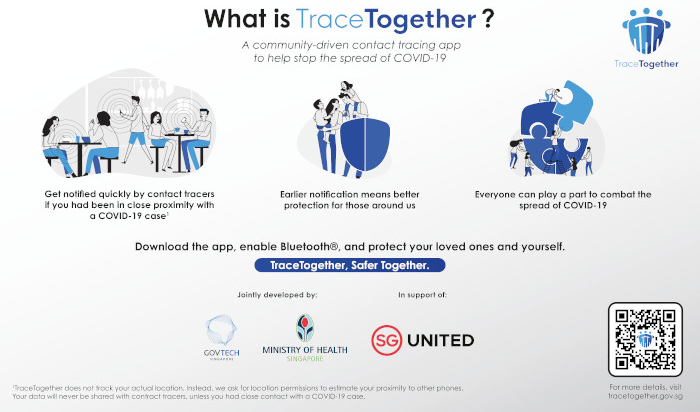
Credit: GovTech, MOH
[UPDATE: According to Singapore's Minister for Foreign Affairs Vivian Balakrishnan's Facebook post on the morning of March 23, TraceTogether has been installed by more than 620,000 users so far.]
The Government Technology Agency of Singapore (GovTech), the in-house IT agency of the Singapore public service, in collaboration with the Ministry of Health (MOH) today announced the launch of a mobile app called TraceTogether, to help support and supplement current contact tracing efforts in the nation-state in an effort to reduce the spread of COVID-19.
HOW IT WORKS
Currently, contact tracing relies on the recall and memory of interviewees. There were however, instances when interviewees could not remember all their contacts, or did not have information on whom they had been in contact with.
TraceTogether works by exchanging short-distance Bluetooth signals between phones to detect other participating TraceTogether users in close proximity. Records of such encounters are stored locally on each user’s phone. If a user is interviewed by MOH as part of the contact tracing efforts, he/she can consent to send his/her TraceTogether data to MOH.
This facilitates the contact tracing process, and enables contact tracers to inform TraceTogether users who are close contacts of COVID-19 cases more quickly. This enables users to take the necessary action sooner, such as monitoring his own health closely for signs of flu-like symptoms.
The TraceTogether app can be downloaded from the Android Google Play or Apple App Store.
PRIVACY SAFEGUARDS
TraceTogether does not collect or use location data of any kind, and does not access a user’s phone contact list or address book. It only uses Bluetooth data to establish a contact and does not store information about where the contact happened.
Secondly, no data is uploaded to the government. All data collected is stored locally on the user’s phone and encrypted. In the event when a person is confirmed to be infected with COVID-19, the government will then request for him/her to upload the data to facilitate contact tracing of his/her close contacts.
If a user does not come into close contact with a COVID-19 case, TraceTogether data older than 21 days will be automatically deleted.
THE LARGER PICTURE
According to the WHO, contact tracing is important as closely watching the contacts after exposure to an infected person will help the contacts to get care and treatment, and will prevent further transmission of a virus. There are three basic steps in contact tracing: contact identification, contact listing and contact follow-up.
In China where the COVID-19 virus is said to have originated, WHO’s Bruce Aylward said that strict quarantine, isolation and contact tracing measures were justified in the name of saving lives, and avoiding the swamping of health systems with seriously ill cases that even developed country health systems often lack capacity to treat, according to a report by Health Policy Watch.
In the case of Singapore, just as the first cases of COVID-19 popped up at the end of January, doctors promptly identified and isolated those people and started contact tracing. As of 20 March 2020, Singapore has a total of 385 confirmed cases with zero COVID-19 related deaths. MOH has identified 7,065 close contacts who have been quarantined. Of these, 2,437 are currently quarantined, and 4,628 have completed their quarantine (as of 12pm, 20 March).
The extensive contact tracing approach by Singapore played a significant role in its efforts to contain the spread of COVID-19 within the country.



















